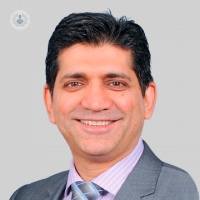Varicocele coil removal explained: Restoring comfort and health
Escrito por:Varicocele coil removal is a minimally invasive procedure that can bring relief to men who have experienced complications after undergoing varicocele embolisation.
Mr Azhar Khan, distinguished Consultant Urological and Robotic Surgeon, explains how varicocele coil removal is performed, the potential risks involved, and the follow-up care required to ensure a smooth recovery.

What is varicocele coil removal, and when is it necessary?
A varicocele is an enlargement of the veins within the scrotum, causing pain, swelling, and in some cases, fertility issues. One of the modern treatment options for varicoceles is varicocele embolisation, a minimally invasive procedure in which a small coil or other embolic materials are placed into the affected veins to block blood flow and reduce the size of the varicocele.
Over time, however, complications may arise from the coils used in embolisation. The coil may shift from its intended site, causing further discomfort or damage to nearby structures. The coil could also fail to completely block the veins, leading to recurrence of the varicocele. In some cases, the coil may need to be removed if the patient experiences persistent symptoms despite embolisation or if another treatment is preferred. In such cases, varicocele coil removal then becomes necessary.
How is varicocele coil removal performed?
Varicocele coil removal is a minimally invasive procedure that can be performed on an outpatient basis, meaning the patient can go home the same day. The procedure is carried out by a urological surgeon, under local anaesthesia or sedation.
To begin, your surgeon will make a small incision, usually in the groin or neck, to access the blood vessels. A catheter will then be inserted into a blood vessel. Using imaging techniques, such as X-ray or ultrasound, your surgeon will carefully navigate the catheter to the site of the varicocele coil. Once the coil is located, your surgeon will remove it from the affected veins through the catheter.
In some cases, robotic surgery may be used for greater precision and control. The robotic system enables your surgeon to use robotic arms controlled by a console, offering enhanced visualisation of the area and more accurate movements than a human hand. This helps to remove the coil without causing damage to surrounding structures.
Are there any risks or potential complications associated with varicocele coil removal?
Like any medical procedure, varicocele coil removal comes with potential risks, though complications are relatively rare. The most common risks associated with the procedure include infection, bleeding, and damage to surrounding structures such as blood vessels or organs. There is also a small risk of injury to the testicle or the vas deferens (the tube that carries sperm).
Pain during the procedure itself is only mild, due to the use of local anaesthesia or sedation. After the procedure, any pain or soreness is usually minimal and can be managed with over-the-counter pain relief medications. The recovery process is relatively quick as well, and most patients are able to resume normal activities within a few days.
What kind of follow-up appointments are required after varicocele coil removal?
Follow-up appointments will typically be scheduled a few weeks after the procedure to ensure there are no complications and that the varicocele doesn’t return. An ultrasound may be performed to confirm there are no issues with the coil site.
If you’re experiencing issues after varicocele embolisation or if you have concerns about a varicocele, it’s important to consult with a qualified urological surgeon to discuss your treatment options.
If you would like to book an appointment with Mr Azhar Khan, head on over to his Top Doctors profile today.


